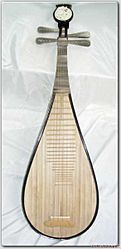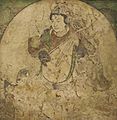Pipa facts for kids
 |
|
| Classification |
|
|---|---|
| Related instruments | |
|
List
|
|
The pipa (Chinese: 琵琶) is a cool musical instrument from China. It has four strings and is played by plucking them. People sometimes call it the Chinese lute.
The pipa has a body shaped like a pear and is made of wood. It has between 12 and 26 frets, which are the raised lines on the neck. Another Chinese instrument, the liuqin, looks like a smaller pipa.
The pipa has been played in China for almost 2,000 years. It might have existed as far back as the Han dynasty. For a long time, the word pipa meant many different plucked string instruments. But since the Song dynasty, it has only referred to this pear-shaped instrument.
The pipa is one of the most popular instruments in China. Other instruments in East Asia and Southeast Asia are similar to the pipa. These include the Japanese biwa, the Vietnamese đàn tỳ bà, and the Korean bipa. The Korean bipa is not used much today, but you can still see examples in museums.
Images for kids
-
Musicians in a scene from paradise, Yulin Cave 25, Tang dynasty
-
Relief sculpture from Gandhara showing a lute being played by a musician (right), 1st–2nd century AD
-
Ladies in palace enjoying an informal concert, Tang dynasty
-
10th century tablature for pipa from Dunhuang Mogao Caves.
-
Scene from a Ming dynasty painting, Tao Gu Presents a Poem, c. 1515, by Tang Yin.
-
A Sui Dynasty (581–618) terracotta pipa-player in a suit of armor
-
Sandstone carving, showing the typical way a pipa was held when played with plectrum in the early period. Northern Wei Dynasty (386–534 AD).
-
Painted panel of the sarcophagus of Yü Hung, depicts one of the Persian or Sogdian figures playing pipa. 592 AD, Sui dynasty.
-
A pipa player playing with the pipa behind his back. Dunhuang, Mogao Caves.
-
An early depiction of pipa player in a group of musicians. From the Dingjiazha Tomb No. 5, period of the Northern Wei (384-441 A.D.)
-
A Song dynasty fresco depicts a female pipa player among a group of musicians
-
Group of female musician from the Five Dynasties and Ten Kingdoms Period (907-960 AD)
-
A mural from a Yuan dynasty tomb found in Hengshan County, Shaanxi, showing a man playing the pipa
-
A group of Qing dynasty musicians from Fuzhou
See also
 In Spanish: Pipa (instrumento) para niños
In Spanish: Pipa (instrumento) para niños
























